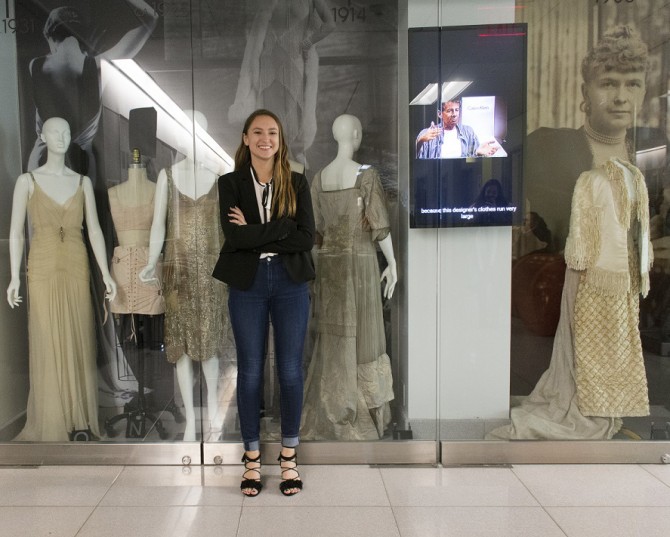'Go Figure' exhibit examines female form
By Stephen D'Angelo
A new costume and textile exhibit at the College of Human Ecology examines how women’s bodies have been manipulated and shaped to fit fashionable silhouettes at different moments through history, from corsets and girdles to diet and exercise.
“‘Go Figure’: The Fashion Silhouette & The Female Form” looks at perceptions and representations of Euro-American ideals of beauty through the 19th, 20th and 21st centuries,” said exhibit curator Rachel Doran ’19. “Body image is something I’ve always been very interested in and this exhibit allowed me to explore the intersection of body image and fashion, and so I looked at ways women control their bodies in how they look.”
“For example, there was a big shift around the 1960s from external controls like corsets and girdles, which are seen in a lot of the earlier pieces, to internal controls, such as diet and exercise, and then later around 2017, the waist trainer came back, bringing external controls back into fashion.”
Doran said her interest in the intersection of body image and fashion stems from as early as middle school, hearing and taking part in discussions around body images portrayed in fashion magazines that set unrealistic expectations for girls who are growing into their own bodies and selves.
According to Doran, the general discussion within the media has died down a bit in recent years, and the inclusion of some plus-size models in the fashion industry has been seen as a positive step. But the main switch in trends most recently has been from incredibly thin models to ones who are hyperfit, which does not necessarily make things better, she said.
“In the 1950s, women aimed to have a fuller figure, so people were taking weight gain supplements,” said Doran. “In the 1960s, that flipped around, and a record number of amphetamines were prescribed for weight loss.”
Moving into the 1970s, Doran said fitness became a key attribute of fashion after women began playing more sports through Title IX, leading to a more athletic figure. The fitness craze continued in the 1980s and with the growing popularity of exercise, control of the body continued to revolve around diet and exercise.
“In the 1990s, the ideal figure became even thinner, where the toned ‘’80s babe’ gave way to the waifish, ‘heroin chic’ supermodel of the ’90s – thin was in,” she said.
From the empire waist of the 1800s to low-rise jeans showing off slim abs in the 2000s, Doran says shaping the human body has been critical to fashion changes and illustrates the dynamic nature of socio-cultural conceptions of “beauty.”
In researching the exhibit, Doran read human development professor Joan Jacobs Brumberg’s book “The Body Project,” introducing her to the idea of internal versus external body controls and what they have meant for women and girls in particular.
Though society has done away with corsetry and its associated health risks, said Doran, we certainly have not done away with unrealistic expectations of the female body. Doran sites national surveys estimating 20 million women and 10 million men will have an eating disorder at some point in their lifetime. Another study found that over 13 percent of young women have suffered from an eating disorder by the time they turn 20.
According to Denise Green, assistant professor of fiber science and apparel design, and director of the Cornell Costume and Textile Collection: “[Doran] spent the last nine months working on this exhibit, made possible by the Charlotte A. Jirousek Undergraduate Research Fellowship, and she spent the entire summer working within the collection through the Human Ecology Undergraduate Research Stipend. She went through every single 19th-century dress that we have in our collection, hundreds and hundreds of dresses.”
The exhibit runs through May 1, 2018.
Stephen D’Angelo is assistant director of communications for the College of Human Ecology.
Media Contact
Get Cornell news delivered right to your inbox.
Subscribe